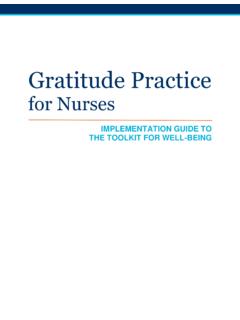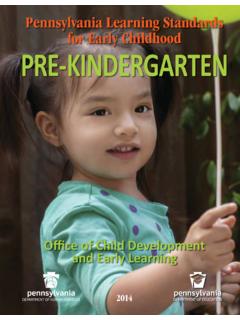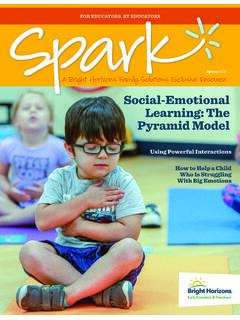Transcription of Thanks! A Strengths-Based Gratitude Curriculum for Tweens ...
1 Thanks! A Strengths-Based Gratitude Curriculum for Tweens and TeensFour lessons to help students understand the meaning of Gratitude and how to cultivate it in their everyday 2 Thanks! A Strengths-Based Gratitude Curriculum for Tweens and TeensTable of ContentsIntroduction 3 Lesson 1: Discover Your Grateful Self 10 Lesson 2: See The Good Challenge 17 Gift of the Magi Reading Gratitude Challenge Activity Gratitude Journal Activity Good Week Reflection Activity Subtracting Good Things ActivityLesson 3: Seeing The Good In Others 35 Go Out And Fill Buckets ActivityLesson 4: Thank You For Believing In Me 43 Gratitude Letter 3 Thanks!
2 A Strengths-Based Gratitude Curriculum for Tweens and TeensIntroductionOver the past two decades, studies have consistently found that people who practice Gratitude report fewer symptoms of illness, including depression, more optimism and happiness, stronger relationships, more generous behavior, and many other , research convincingly shows that, when compared with their less grateful peers, grateful youth are happier and more satisfied with their lives, friends, family, neighborhood, and selves. They also report more hope, engagement with their hobbies, higher GPAs, and less envy, depression, and s why the Greater Good Science Center launched the Youth Gratitude Project (YGP) as part of the broader Expanding the Science and Practice of Gratitude , a multiyear project funded by the John Templeton Foundation.
3 In addition to advancing the knowledge of how to measure and develop Gratitude in children, the YGP created and tested a new Gratitude Curriculum for middle and high main idea of the YGP Curriculum is that varied Gratitude practices should help students feel more socially competent and connected, be more satisfied with school, have better mental health and emotional well-being, and be more motivated about school and their future. For example, practices like journaling that genuinely build on students strengths and guide them to have more meaningful interactions and regular discussion with peers, teachers, and other evidence for the effects of the Gratitude Curriculum indicate that it is helping to decrease depression, anxiety, and antisocial behavior and increase hope, emotional regulation, and search for purpose.
4 4 Thanks! A Strengths-Based Gratitude Curriculum for Tweens and TeensIntroductionHow To Use The LessonsIn describing the design of the Gratitude Curriculum , lead researcher Dr. Giacomo Bono writes: Gratitude interventions for students should start by identifying and engaging students character strengths and interests, and they should let students appreciate the different benefits and benefactors in their lives for themselves. Let s go beyond lists and dry journals. When people get us and help us through tough times, Gratitude grows.
5 Schools participating in the YGP Curriculum have shared anecdotes about students and parents enthusiasm for the Gratitude lessons. Indeed, the character strength and Gratitude exercises have not only been affirmational strengthening pride in students achievements and building a sense of community but, according to Dr. Bono, they have also been hijacking much of the wall space at Open Houses! We sincerely hope that, as students begin to practice Gratitude , they will begin to see the value of altruistic choices and recognize the good intentions of others, helping them to feel supported in reaching for the lesson follows a consistent format:Time Required: The time required is a suggested time based on feedback from educators who have taught the lesson.
6 For the full benefit, lessons should be taught in their entirety, which may take one or two class Level: The lessons were designed for both middle and high school students; however, teachers should feel free to adapt the lessons to meet the needs of their : The materials listed for each activity are deliberately simple and low-cost. An internet connection and a TV or projector will be required to show the videos. Links to PDFs of handouts and PowerPoint slides are included with the Curriculum . 5 How To Use The Lessons (cont d) learning Objectives: The learning objective describes the knowl-edge, skills , and/or attitudes that are developed in each activity.
7 social and emotional learning (SEL) competencies : social and emotional learning (SEL) is the process through which children learn and apply the knowledge, attitudes, and skills necessary to: Understand and manage emotions Set and achieve positive goals Feel and show empathy for others Establish and maintain positive relationships Make responsible decisionsFive social - emotional competencies have been identified by the Collaborative for Academic, social , and emotional learning (CASEL) as foundational. The table on the next page lists those competencies , and ways in which Gratitude practices can support their CompetenciesHow Gratitude Practices Support This CompetencySelf-awareness: The ability to accurately recognize one s emotions and thoughts and their influence on behavior.
8 This includes accurately assessing one s strengths and limitations and possessing a well-grounded sense of confidence and develop a deeper awareness of their thoughts and feelings when they reflect mindfully on their experience of Gratitude . Choosing to express Gratitude also enhances students confidence and : The ability to regulate one s emotions, thoughts, and behaviors effectively in different situations. This includes managing stress, controlling impulses, motivating oneself, and setting and working toward achieving personal and academic to respond with Gratitude , when experiencing kindness from others, requires students to regulate their thoughts, feelings and !
9 A Strengths-Based Gratitude Curriculum for Tweens and TeensIntroduction 6 How To Use The Lessons (cont d)SEL competencies (cont d)How Gratitude Practices Support This Competency (cont d) social awareness: The ability to take the perspective of and empathize with others from diverse backgrounds and cultures, to understand social and ethical norms for behavior, and to recognize family, school, and community resources and considering the intentions and efforts of those they are grateful to, students develop social awareness. In particular, they develop the ability to take the perspective of others and to empathize with skills : The ability to establish and maintain healthy and rewarding relationships with diverse individuals and groups.
10 This includes communicating clearly, listening actively, cooperating, resisting inappropriate social pressure, negotiating conflict constructively, and seeking and offering help when they express Gratitude , students establish and maintain healthy relation-ships with others. Planning and carrying out acts of kindness toward others also strengthens relationship decision making: The ability to make constructive and respectful choices about personal behavior and social interactions based on consideration of ethical standards, safety concerns, social norms, the realistic evaluation of consequences of various actions, and the well-being of self and choosing to express Gratitude , students practice responsible decision-making and enhance the well-being of others, themselves and the world around Ready for This Activity.








